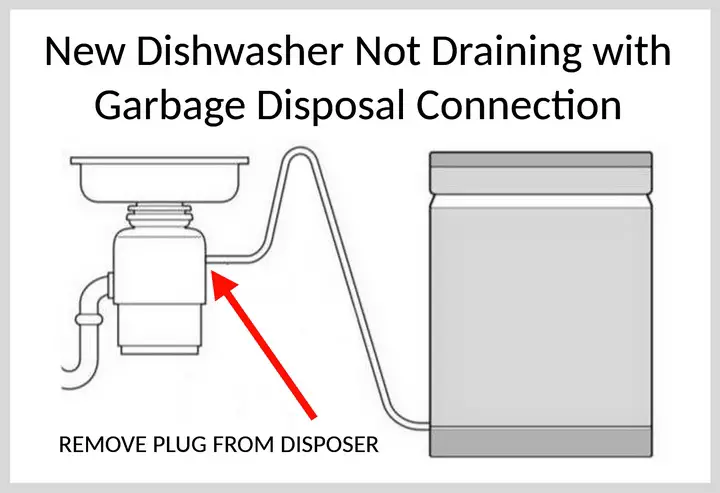When a dishwasher is newly installed and connected to a garbage disposal system, it’s important to ensure proper setup to prevent drainage issues. One common oversight during installation is forgetting to remove the plug from the port where the dishwasher drain hose connects to the garbage disposal.
 New dishwasher not draining? Check garbage disposal
New dishwasher not draining? Check garbage disposal
This plug is designed to prevent water from leaking out of the garbage disposal when a dishwasher isn’t connected. However, if it’s not removed, it will block the dishwasher’s ability to drain water properly, leading to pooling water and potential error codes.
Here is how to check and remove the plug from your garbage disposal system, ensuring proper drainage for your newly installed dishwasher.
Check and Remove the Garbage Disposal Plug
Follow these steps to check and remove the plug from your garbage disposal system:
Step 1: Turn Off the Power
Ensure the dishwasher and garbage disposal are both switched off and disconnected from the power source to avoid any accidents or electrical hazards. You can do this by unplugging the appliances or turning off the circuit breaker that controls their power.
Step 2: Locate the Dishwasher Drain Hose Connection
Look beneath your sink and find where the dishwasher drain hose connects to the garbage disposal. The connection point often looks like a small tube protruding from the side of the garbage disposal unit.
Step 3: Check for the Plug
Inspect the connection point to see if the plug is still in place. If you see a solid plastic or rubber piece blocking the opening, this means the plug has not been removed. It’s important to check for the plug before attempting to remove it, as some garbage disposals may not have one or may have already had it removed during installation.
Step 4: Remove the Plug
Use a screwdriver, pliers, or any appropriate tool to carefully remove the plug from the connection point. Be gentle to avoid causing any damage to the garbage disposal or the dishwasher drain hose. If the plug is difficult to remove, you may need to apply a bit of force or use a lubricant to help loosen it.
How to remove plug from disposal
Step 5: Reconnect the Drain Hose
Once the plug is removed, reconnect the dishwasher drain hose to the garbage disposal, ensuring a secure and watertight connection. You may need to use a hose clamp or a similar device to keep the hose in place and prevent leaks.
Step 6: Test the Dishwasher
Turn the power back on for both the dishwasher and garbage disposal. Run a cycle on your dishwasher to ensure it’s draining correctly. Keep an eye on the connection point for any leaks or issues while the dishwasher is in operation. If you notice any problems, you may need to tighten the connection or address other potential issues with the dishwasher or garbage disposal system.
Proper Dishwasher Drainage
Understand the importance of proper dishwasher drainage. A dishwasher needs to drain water effectively to function correctly. Here is what happens when you have a dishwasher that will not drain.
- Water pooling at the bottom of the dishwasher
- Unpleasant odors due to stagnant water
- Reduced cleaning efficiency, leading to dirty dishes
- Potential damage to the dishwasher and other connected systems
By ensuring proper drainage, you can avoid these issues and extend the lifespan of your dishwasher.
Always exercise caution when working with appliances and electrical systems. If you’re unsure about any aspect of this process, it’s best to consult a professional plumber or appliance technician for assistance.



Leave a Reply